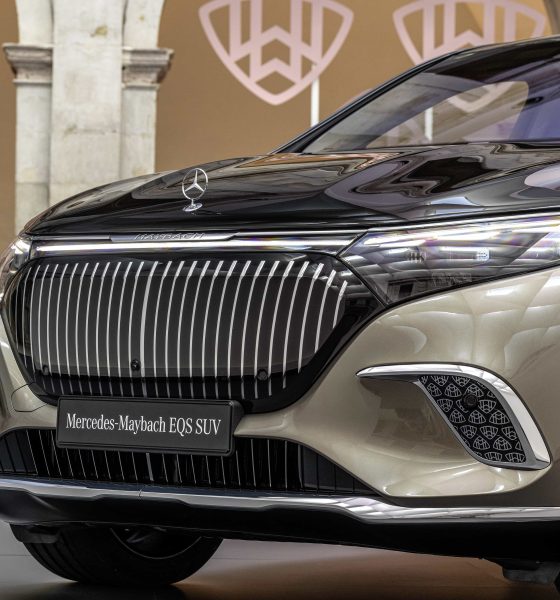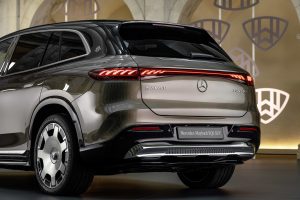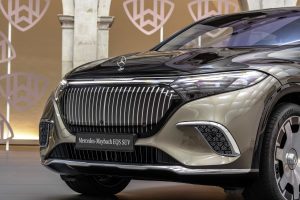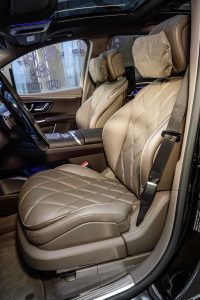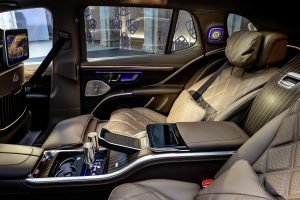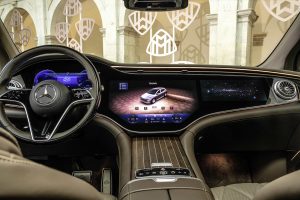Mercedes has unveiled its first ultra-luxury electric vehicle, the Maybach EQS SUV.
Maybach has made a name for itself by taking the already well-known premium driving experience of Mercedes and taking it to another level. The brand’s most recognizable vehicle, the Maybach S-Class, challenges the luxury and price tag of Rolls-Royce and often does so quite successfully. Now, Mercedes has introduced its first ultra-luxury electric vehicle, the Maybach EQS SUV.
If it isn’t apparent from the vehicle’s profile and name, the Maybach EQS SUV is based on the Mercedes EQS SUV, which is already a luxury offering in its own right. However, with an expected price tag north of $200,000, it makes its Mercedes counterpart look like an affordable offering.
- Credit: Mercedes-Maybach
Besides the noticeable styling changes, primarily in paintwork and trim pieces, the Maybach EQS SUV receives a modest mechanical upgrade over the already well-performing EQS SUV. First, the vehicle comes standard as a dual motor all-wheel-drive configuration, but it now produces a massive 649 horsepower and 700 pound-feet of torque. Despite the increase in power output and no physical capacity change to the battery (107.8kWh), the Maybach achieves roughly 70 more miles of range, 372 miles on a full charge.
The Maybach still charges in the same respectable 30 minutes from 10-80% as the Mercedes EQS SUV.
“The Mercedes-Maybach EQS SUV is a milestone in our brand history, says Daniel Lescow, Head of Mercedes-Maybach. “For us, it embodies nothing less than the redefinition of automotive excellence in the age of electromobility. Our customers can look forward to an absolutely top-class electric driving experience – with the aura of the extraordinary that is typical of Maybach.”
Ironically, while the performance bump is undoubtedly a welcome inclusion, Maybach, as usual, has made its focus clear; an incredible interior experience.
The Mercedes Maybach team has woven incredible comfort and luxury with the highest tech and suitability possible. Materials throughout the cabin, including the Nappa leather, aluminum trim, and suede accents, have all been responsibly sourced or made from recycled materials. As for the tech offering, it is top-notch. Both from and rear passengers have access to massive screens and a suite of seat comfort settings fit for those who can afford to be driven in them.
This focus on tech and interior software experience is even noted by Ola Källenius, Chairman of the Board of Management Mercedes-Benz, in his statement on the unveiling. “The Mercedes‑Maybach EQS SUV unites our ambition to lead in digital and electric with our focus on the luxury segment. The very first all-electric vehicle from Mercedes-Maybach complements the best technologies from Mercedes‑Benz with the extra comfort and individual details that are only available from Mercedes‑Maybach.”
While the Maybach offering will certainly not be a mass-market seller, the brand is often the pioneer of technologies and materials that eventually make their way to entry-level Mercedes offerings. Mercedes has previously noted that it will be using an increasing amount of recycled materials within its vehicles, and hopefully, the Maybach EQS SUV is just the tip of the iceberg.
What do you think of the article? Do you have any comments, questions, or concerns? Shoot me an email at william@teslarati.com. You can also reach me on Twitter @WilliamWritin. If you have news tips, email us at tips@teslarati.com!

News
Tesla starts showing how FSD will change lives in Europe
Local officials tested the system on narrow country roads and were impressed by FSD’s smooth, human-like driving, with some calling the service a game-changer for everyday life in areas that are far from urban centers.

Tesla has launched Europe’s first public shuttle service using Full Self-Driving (Supervised) in the rural Eifelkreis Bitburg-Prüm region of Germany, demonstrating how the technology can restore independence and mobility for people who struggle with limited transport options.
Local officials tested the system on narrow country roads and were impressed by FSD’s smooth, human-like driving, with some calling the service a game-changer for everyday life in areas that are far from urban centers.
Officials see real impact on rural residents
Arzfeld Mayor Johannes Kuhl and District Administrator Andreas Kruppert personally tested the Tesla shuttle service. This allowed them to see just how well FSD navigated winding lanes and rural roads confidently. Kruppert said, “Autonomous driving sounds like science fiction to many, but we simply see here that it works totally well in rural regions too.” Kuhl, for his part, also noted that FSD “feels like a very experienced driver.”
The pilot complements the area’s “Citizen Bus” program, which provides on-demand rides for elderly residents who can no longer drive themselves. Tesla Europe shared a video of a demonstration of the service, highlighting how FSD gives people their freedom back, even in places where public transport is not as prevalent.
What the Ministry for Economic Affairs and Transport says
Rhineland-Palatinate’s Minister Daniela Schmitt supported the project, praising the collaboration that made this “first of its kind in Europe” possible. As per the ministry, the rural rollout for the service shows FSD’s potential beyond major cities, and it delivers tangible benefits like grocery runs, doctor visits, and social connections for isolated residents.
“Reliable and flexible mobility is especially vital in rural areas. With the launch of a shuttle service using self-driving vehicles (FSD supervised) by Tesla in the Eifelkreis Bitburg-Prüm, an innovative pilot project is now getting underway that complements local community bus services. It is the first project of its kind in Europe.
“The result is a real gain for rural mobility: greater accessibility, more flexibility and tangible benefits for everyday life. A strong signal for innovation, cooperation and future-oriented mobility beyond urban centers,” the ministry wrote in a LinkedIn post.
News
Tesla China quietly posts Robotaxi-related job listing
Tesla China is currently seeking a Low Voltage Electrical Engineer to work on circuit board design for the company’s autonomous vehicles.

Tesla has posted a new job listing in Shanghai explicitly tied to its Robotaxi program, fueling speculation that the company is preparing to launch its dedicated autonomous ride-hailing service in China.
As noted in the listing, Tesla China is currently seeking a Low Voltage Electrical Engineer to work on circuit board design for the company’s autonomous vehicles.
Robotaxi-specific role
The listing, which was shared on social media platform X by industry watcher @tslaming, suggested that Tesla China is looking to fill the role urgently. The job listing itself specifically mentions that the person hired for the role will be working on the Low Voltage Hardware team, which would design the circuit boards that would serve as the nervous system of the Robotaxi.
Key tasks for the role, as indicated in the job listing, include collaboration with PCB layout, firmware, mechanical, program management, and validation teams, among other responsibilities. The role is based in Shanghai.
China Robotaxi launch
China represents a massive potential market for robotaxis, with its dense urban centers and supportive policies in select cities. Tesla has limited permission to roll out FSD in the country, though despite this, its vehicles have been hailed as among the best in the market when it comes to autonomous features. So far, at least, it appears that China supports Tesla’s FSD and Robotaxi rollout.
This was hinted at in November, when Tesla brought the Cybercab to the 8th China International Import Expo (CIIE) in Shanghai, marking the first time that the autonomous two-seater was brought to the Asia-Pacific region. The vehicle, despite not having a release date in China, received a significant amount of interest among the event’s attendees.
Elon Musk
Elon Musk and Tesla AI Director share insights after empty driver seat Robotaxi rides
The executives’ unoccupied tests hint at the rapid progress of Tesla’s unsupervised Robotaxi efforts.

Tesla CEO Elon Musk and AI Director Ashok Elluswamy celebrated Christmas Eve by sharing personal experiences with Robotaxi vehicles that had no safety monitor or occupant in the driver’s seat. Musk described the system’s “perfect driving” around Austin, while Elluswamy posted video from the back seat, calling it “an amazing experience.”
The executives’ unoccupied tests hint at the rapid progress of Tesla’s unsupervised Robotaxi efforts.
Elon and Ashok’s firsthand Robotaxi insights
Prior to Musk and the Tesla AI Director’s posts, sightings of unmanned Teslas navigating public roads were widely shared on social media. One such vehicle was spotted in Austin, Texas, which Elon Musk acknowleged by stating that “Testing is underway with no occupants in the car.”
Based on his Christmas Eve post, Musk seemed to have tested an unmanned Tesla himself. “A Tesla with no safety monitor in the car and me sitting in the passenger seat took me all around Austin on Sunday with perfect driving,” Musk wrote in his post.
Elluswamy responded with a 2-minute video showing himself in the rear of an unmanned Tesla. The video featured the vehicle’s empty front seats, as well as its smooth handling through real-world traffic. He captioned his video with the words, “It’s an amazing experience!”
Towards Unsupervised operations
During an xAI Hackathon earlier this month, Elon Musk mentioned that Tesla owed be removing Safety Monitors from its Robotaxis in Austin in just three weeks. “Unsupervised is pretty much solved at this point. So there will be Tesla Robotaxis operating in Austin with no one in them. Not even anyone in the passenger seat in about three weeks,” he said. Musk echoed similar estimates at the 2025 Annual Shareholder Meeting and the Q3 2025 earnings call.
Considering the insights that were posted Musk and Elluswamy, it does appear that Tesla is working hard towards operating its Robotaxis with no safety monitors. This is quite impressive considering that the service was launched just earlier this year.

